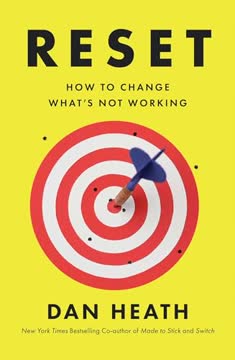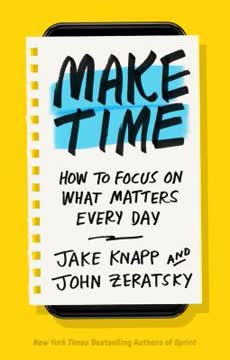Key Takeaways
1. Drop Everything and Sprint for Focused Progress
Drop everything and sprint on the most important challenge until it’s done.
Escape the chaos. The traditional way of starting projects involves endless meetings, emails, and context switching, scattering effort across tiny islands of time. This prevents the intense focus needed for ambitious work. Clearing calendars and dedicating uninterrupted time allows teams to achieve a continent of progress.
Call a time-out. To overcome the modern workplace's distractions, make the difficult decision to declare a "good emergency." This means pausing routine tasks and coming together with a small, dedicated team (ideally 5 people or less, including the Decider) to focus intensely on one important goal. The Decider's involvement is crucial for clearing schedules and making swift decisions.
Work alone together. Avoid unproductive group brainstorms. Instead, use methods like Note-and-Vote where individuals think and propose solutions in silence, then review and vote anonymously. This leverages diverse perspectives, speeds up decision-making, and leads to higher-quality outcomes than consensus-driven discussions.
2. Start by Identifying Your Customer and Their Real Problem
Start by identifying your customer and a real problem you can solve.
Put the customer first. Many projects fail because they focus on what the company wants (like the "Skyscraper Robot" toy executive) rather than what customers need. Treating customers as honored guests and understanding their genuine problems is fundamental to creating something they will care about.
Define the basics clearly. Even seemingly obvious questions like "Who is your customer?" and "What problem are you solving?" are often unclear within teams. Use plain language, avoiding jargon, to define these basics crisply. For Google Meet, the customer was "teams with people in different locations" and the problem was "it was difficult to meet."
Use Note-and-Vote. Employ the Note-and-Vote method to collaboratively identify and decide on your target customer and the specific problem you aim to solve for them. This ensures everyone's perspective is considered and leads to a shared understanding, forming the first fiber of your strategy.
3. Leverage Your Team's Unique Advantages
Take advantage of your advantages.
Avoid mediocrity. Many teams mimic existing solutions instead of capitalizing on what makes them unique. Ignoring your advantages leads to blending in, while leveraging them allows you to stand out and create solutions others cannot.
Identify your strengths. Your team's unique advantages come in three flavors: capability (what you can do few others can), motivation (the specific fire driving you), and insight (deep understanding of the problem or customer). Phaidra's founders combined AI capability, mechanical engineering insight, and frustration with inefficiency.
Capability + Insight + Motivation. The combination of these elements creates a powerful, unique advantage. Use the Note-and-Vote to identify your team's specific capabilities, insights, and motivations, choosing the most important one in each category. This shapes your strategy towards a solution only your team can deliver.
4. Get Real About the Competition and Alternatives
Get real about the competition.
Understand the landscape. To make your product click, it must beat the alternatives in the customer's mind. This requires an honest assessment of the competition, not naive dismissal. Nike, facing Converse and Adidas, had to understand their rivals deeply to find an opening.
Identify all rivals. Competition isn't just direct competitors. It includes:
- Direct competitors (other companies solving the same problem)
- Substitutes (workarounds customers use, like manual adjustments for Phaidra)
- "Do nothing" (the riskiest, but sometimes most exciting, competition)
Go for the gorilla. Don't shy away from comparing yourself to the strongest alternative, even if it's the status quo (like email for Slack). Setting your sights high pushes you to create a truly superior solution that stands out from the best, not just the rest.
5. Radical Differentiation Makes Products Click
The most successful products don’t just differentiate a little—they create radical separation from the competition.
Why customers switch. Change has a cost for customers (money, time, effort, risk). Your solution must stand out significantly to justify this cost. Differentiation is the essence of your solution, capturing attention and explaining why the new way is better.
Create a new framework. The most successful products don't just offer a better solution; they change how customers evaluate solutions entirely. They highlight factors customers hadn't considered or thought couldn't be improved, like Google Meet's "just a browser" simplicity or Orbital Materials' focus on "quality" and "reliability" over traditional trial-and-error.
Visualize with a 2x2. Use a 2x2 chart to map your solution against competitors based on two key differentiators. Aim for "realistic optimism" to find factors that place your project alone in the top right quadrant ("Loserville" for the competition). This chart becomes a powerful, simple guide for your team and customers.
6. Use Practical Principles to Guide Decisions
Decision-making requires relevant opinions, not cultural clichés or vague ideals.
Principles for action. Abstract company values are often ignored. Practical principles, like Google's "Fast is better than slow," provide clear, actionable guidance for decision-making throughout a project. They reinforce your differentiation and energize the team.
Turn differentiators into principles. Your two key differentiators from the 2x2 chart can become powerful principles. Ask: "What advice ensures we deliver on this differentiation?" For example, ASI's "student-led" differentiation became "Remove the fog in academic exploration."
Differentiate, differentiate, safeguard. Aim for three principles: one for each key differentiator, and one "safeguard" principle to prevent unintended negative consequences. Phaidra's "Empower don't replace" principle ensured their AI augmented engineers, not replaced them. Use Note-and-Vote to draft and select principles quickly.
7. Seek Alternatives to Your First Idea
But what if you could pivot before you even began?
Pre-pivot for efficiency. Your first idea is rarely the best. Pivoting after building a product is time-consuming and costly. The Foundation Sprint allows you to explore multiple approaches before committing, like Genius Loci considering physical signs and a website instead of just their initial app idea.
Generate multiple options. Don't stop at your first idea. Actively brainstorm alternative approaches. Ask:
- What if our first idea fails?
- How would a new competitor solve this?
- Could we target a different customer?
Summarize clearly. For each viable approach (aim for 3-7), create a one-page summary including its title, a one-sentence pitch referencing the problem and differentiation, and a quick doodle. This ensures everyone understands each option equally before evaluation.
8. Evaluate Options Through Different Lenses
Consider conflicting opinions before you commit to an approach.
Structured argument. Big decisions require considering conflicting opinions, even if your team agrees. Magic Lenses provide a visual method to evaluate multiple project approaches from different perspectives without personal bias or politics.
Use a "team of rivals". Evaluate options through classic lenses representing different priorities:
- Customer lens (dream solution)
- Pragmatic lens (easiest/fastest to build)
- Growth lens (scaling the business)
- Money lens (profitability)
Create custom lenses. Go beyond the classics by creating lenses based on criteria critical to your project's success, like Genius Loci's "middle-of-nowhere lens" or Reclaim's "Revenue + Cure" lens. Plot each approach on 2x2 charts for each lens. Zoom out to find patterns and make an informed decision on your top approach and a backup.
9. Your Strategy is Just a Hypothesis Until Proven
It’s just a hypothesis until you prove it.
Avoid cognitive biases. Humans are prone to biases like anchoring (loving the first idea), self-serving bias, overconfidence, and confirmation bias (seeking data that confirms beliefs). These biases push teams to commit to unproven ideas, like Le Verrier's eighteen-year search for the non-existent planet Vulcan.
Embrace uncertainty. Your Foundation Sprint output is not a rigid plan, but a "Founding Hypothesis." This Mad Libs-style sentence (For [customer], who wants to solve [problem], our solution [approach] is better than [competition] because [differentiation 1] and [differentiation 2]) makes your core predictions explicit.
Test your predictions. Every element of the Founding Hypothesis is a prediction that needs testing. Instead of waiting a year or more to build and launch a full product to see if it clicks, use tiny loops to test these predictions immediately. This allows you to learn fast and adjust your hypothesis before investing heavily.
10. Experiment with Tiny Loops Until It Clicks
Experiment with tiny loops until your solution clicks. Then build it.
Escape long loops. Ambitious projects typically take a year or more to launch, making real-world data slow to arrive. This long feedback loop is stressful and inefficient. Tiny loops, like the weekly tests of a video game prototype or Phaidra's sprint-based testing, provide rapid learning cycles.
Use Design Sprints. The Design Sprint is a five-day process designed for tiny loops: map the problem (Mon), sketch solutions (Tue), decide (Wed), prototype (Thu), test with customers (Fri). This time machine lets you see customer reactions before building, de-risking your project significantly.
Test prototypes, not MVPs. While MVPs are faster than full launches, they still take months. Prototypes are realistic fakes that can be built in a day, allowing you to test multiple solutions head-to-head and pit them against the competition. Watch for genuine customer reactions (leaning in, asking to sign up) as signals that your solution is clicking. Repeat sprints, adjusting your hypothesis and prototype, until you build confidence.
Last updated:
Review Summary
Click is a concise guide for product development, focusing on testing and validating minimal viable products. Readers find it practical and easy to apply, though some note it lacks groundbreaking insights. The book offers a structured framework for early-stage product development, which some appreciate for its simplicity and efficiency. While not revolutionary, it provides useful formats for collaboration and ideation. The book's storytelling, examples, and visual elements are praised, making it an engaging read for founders and product developers.
Similar Books










Download PDF
Download EPUB
.epub digital book format is ideal for reading ebooks on phones, tablets, and e-readers.






